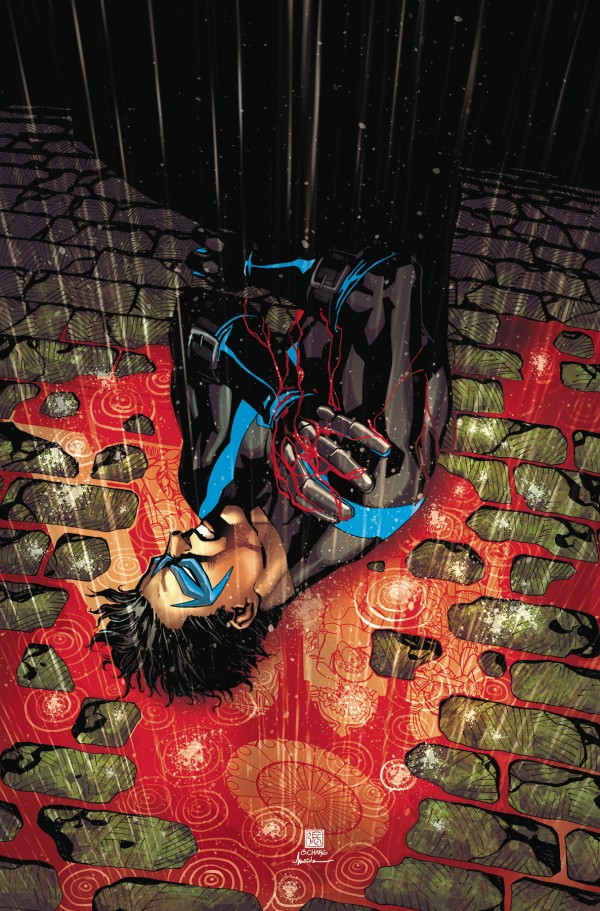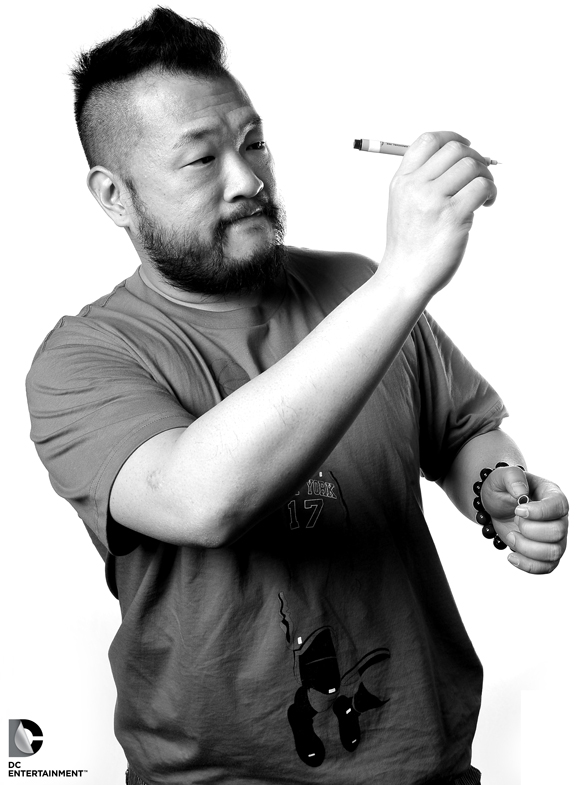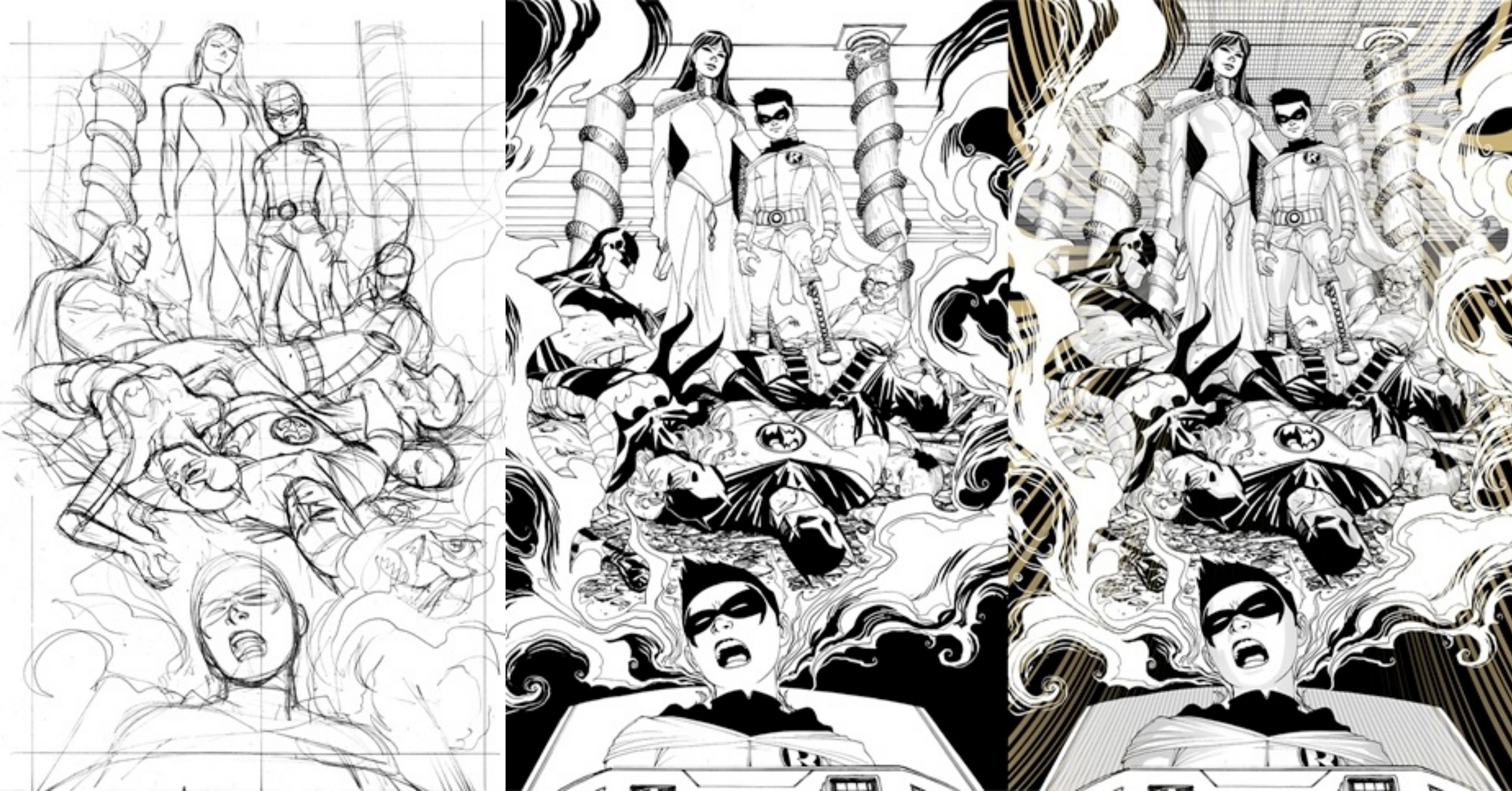Exclusive Interview: Bernard Chang – Artist On ‘Batman Beyond’ And ‘Nightwing’
Interview by Steve J. Ray
Bernard Chang is an award winning artist, designer and former Disney Imagineer. He is a comics veteran, and has drawn for virtually every American comics publisher.
Bernard Chang is an award winning artist, designer and former Disney Imagineer. He is a comics veteran, and has drawn for virtually every American comics publisher.
In December, after an incredible three year run with legendary comics creator Dan Jurgens, Bernard will be leaving Batman Beyond. The good news is that he's taking over as artist on Nightwing, collaborating with Green Lanterns writer Sam Humphries.
Bernard has drawn almost every issue of Batman Beyond; for a year on DC: Rebirth, and throughout the New 52. Since joining DC, he has drawn almost every character, having pencilled DC Comics Presents, Superman, Supergirl, and Wonder Woman, amongst others.
Bernard has drawn almost every issue of Batman Beyond; for a year on DC: Rebirth, and throughout the New 52. Since joining DC, he has drawn almost every character, having pencilled DC Comics Presents, Superman, Supergirl, and Wonder Woman, amongst others.
I have been fortunate enough to review Batman Beyond for the last 7 months, and love the book so much that I even went back and purchased all the collected editions featuring his work. After a few great on-line conversations with Mr. Chang, I was fortunate enough to be granted this world exclusive interview.
So, without further ado; ladies and gentlemen, FANtastic Universes is extremely proud to present:
Bernard Chang: Exclusive Interview
Steve J. Ray: Hi Bernard. Thanks so much for taking time out for this interview. I appreciate that you have deadlines and that every moment is precious. I’m a huge fan of your work, and know that you’ve drawn comics for Valiant, Marvel, and now for DC. What are the differences, if any, between working for each publisher?
Bernard Chang: My rookie year in comics was 1992, with Valiant Comics. Since, I’ve worked on titles for Marvel, DC, and other publishers such as Harper Collins, Disney, Amazon and even the United Nations. Aside from the differences in characters and universes, there really isn’t much of a major difference in how publishers work.
The biggest shift has mostly been in the writing, in two parts; one, being the current trend to have four to six issue arcs, whereas when I first started, single-issue stories were perhaps more common; and two, the current trend towards working from full scripts versus plot format – although my last two series have made an effort to return to that style.
SJR: That’s really interesting. I’ve been fortunate enough to interview two of the phenomenal pencillers on Detective Comics (Álvaro Martínez and Carmen Carnero) who have always worked using the full script format. What about drawing itself? Do you work in the traditional manner, of pencils on art-board, then inks? Or do you draw digitally?
BC: I work in both traditional pencil/ink on paper, and digital production. It’s still faster and more efficient for me to draw things on paper first, but the final piece still gets scanned into the computer and cleaned up/enhanced with digital tools. My main drawing process is sort of unique, something I learned from my good friend, Sean Chen, who in-turn learned it from Chris Sprouse – and that’s to do the rough pencils on the back of the bristol board (in reverse) and then light pencil and ink on the front. this process gives me another layer for self-edits, as well as drawing revisions, and generally results in a very clean and sharp finished piece.
If you’re an aspiring artist, I would highly recommend learning how to use some digital tools. There are many artists today that draw everything digitally and do it flawlessly! There have been projects I’ve drawn completely digitally, but for mainstream comics stuff, I still go traditional.
What is probably more interesting is that the first issue of my upcoming Nightwing, some parts of it were drawn at my home studio, others during jury duty, on a plane over the pacific ocean, and at a hotel!
SJR: Wow, that’s crazy! I’ll definitely be reading that issue with a different perspective now.
Breaking Into The Business
SJR: So, looking back – what was it like when you saw your completed work in print for the first time? Is it still exciting now?
BC: My first ever assignment was a fill-in issue of Archer and Armstrong (#9), but due to publishing timelines, my second gig, Hard Corps (#5) was printed a month or so earlier. I remember the day that first issue came out. I hit up a comic book store in Manhattan near 6th Ave /14th Street (forgot the name, but it was a second story walkup that had all these comic book posters plastered in the dark and creaky stairwell) and I kinda hung out in the corner pretending to be looking through some old comics bins, waiting for people to pick the issue up and flip through it and gauge their expression. I was 20 years old and a childhood dream had come true!
I didn’t engage anyone that day, just kinda hung out for like 30 minutes or so, and then had to head back to campus for basketball practice (I was attending the Pratt Institute in Brooklyn).
Nowadays, the excitement of a new issue release is not as huge as that very first issue, but I am still very humbled and fortunate to have built a career based on childhood ambitions.
Each And Every Highway
SJR: I find your art very vibrant and dynamic. Who are your inspirations? Comic and non – comic related.
BC: I’ve been drawing as long as I can remember. I studied art throughout grade school, attended one of the best arts magnet high schools in the nation (New World School Of The Arts in Miami, Fl.), and earned a Bachelors degree in architecture in college. I feel my art or storytelling is a reflection of my past experiences. In art high school, the teachers actually forbade us from drawing comics stuff. It was a strict fine arts curriculum, which I actually encourage all young aspiring artists to undergo. They were correct in forcing us to draw from real life, explore and expand creative boundaries. That’s why I guess my work has never “looked” like another artist’s style. you can kinda say, “I did it my way”. Haha.
The Guy That Killed Superman
SJR: That’s certainly true. I’ve often said in my reviews that your style marries realism with the comics style seamlessly, making you the perfect artist to work with Dan Jurgens on Batman Beyond. Now, Dan is a comics legend. What’s it like working with him? Are there any writers you’d really like to collaborate with in the future?
BC: Dan Jurgens is a legend period. We first met when he came over to Valiant to take over Solar. I had been a great admirer of his work, in particular his ability to write and draw and tell great, impactful stories. So when Batman Beyond became available, it was an instant “Yes” to collaborate with him.
It was also a treat in that we got to return to our storytelling roots and work from plot first as opposed to full scripts. It reflected the confidence Dan and the editors had in me, in terms of storytelling. Each month as I’m reading the plot, the stories all have a nice hook that had me wanting to read the next issue’s plot, and I think I learned a lot from just absorbing some of what Dan had written. In addition, Dan being a great artist really lent to his stories, as they naturally have a very visual and dynamic narrative.
As for other writers to collaborate with in the future, the list is constantly evolving. Part of the fun of working in comics, aside from drawing your favorite characters, are the people you get to work with and the relationships you build that are part of your life. I can say I’ve been very, very fortunate to have worked with some of the best, coolest, and most creative people around. Bob Layton, who was my mentor and like a father-figure back at Valiant, to Sam Humphries, the writer on Nightwing now. Each have their own voice and magic.
Writer And Artist
SJR: When we first started this interview, I asked if you had any aspirations to one day write your own comics. A couple of weeks back, that question was answered, when DC published Batman Beyond#13. This issue featured your script, your pencils and inks! Great job. I loved the issue and your innovative script and layouts.
BC: Thanks so much. Writing my own stories is something I look forward to taking a larger part in my career, moving forward. Having now written my first full comic in the recent Batman Beyond, I can tell you it was a ton of fun. But I also have a few creator-owned concepts brewing in my head which are at various levels of completion. Part of that is to find enough time in the day to explore those ideas and sharpen that muscle.
SJR: Based on the one issue that you’ve written so far, I can’t wait! Are there any DC characters you haven’t drawn yet, that you’d like to?
BC: I’ve been the main artist on Superman, Wonder Woman, Supergirl, Green Lantern, Batman Beyond and now Nightwing. I guess if I could ask for more, I’d say id like to round out the rest of the Super Friends / Justice League, since they were my first introduction into American superhero comics, when my family and I immigrated to the United States back in the late ’70s. So, Flash? Aquaman? Batman! But I also had a friend in junior high that loved Firestorm, so it would be cool to do an issue with the Nuclear Man and share that with him, since we were such comic book nerds back then, not that we aren’t the same diehards now, but it would just be a cool nostalgic thing.
Design And Technology
SJR: I’ve totally loved your art on Batman Beyond and your re-design of Terry’s costume. Can you tell me a little about it?
BC: Every book I draw, I try to infuse some of my design sensibilities into it. With Beyond, the editorial team and Dan were generous enough to hand me some more responsibilities, and when the first arc of “Rebirth” concluded, it was evident that the batsuit would be damaged, so they asked for some new takes. One of my main focuses was on how the suit’s nanites might be utilized to create new futuristic weaponry. Like if his wings can expand and retract, why can’t other parts of suit do the same? If that is the case, then why can’t some of it be used as blades or other close-range combat weapons?
The red streaks symbolized the danger levels of the situation, so if you flip back thru the run, when he was fighting, they were more prominent and some transformed into blades and other weapons. I’m also very into athletic gear so I studied how modern athletes uniforms have seams and panels tailored to enhance movement and performance. I really wanted to add some accents that helped give Terry a more aggressive feel – that even when he was standing still, he still looked like he was moving and attacking. One of Batman’s first initiatives was to instill fear in criminals based purely on his look, so what is the futuristic translation of that?
SJR: That’s so cool! I’m going to have to read them all again… Like I really needed an excuse! So, leading from Batman Beyond, are you a big Batman fan? Have you always been?
BC: Isn’t everyone a Batman fan? Haha. I watched Batman Beyond when it first came out on TV, but was not a completist. But, as I started working on the book two and a half years ago, I started studying and watching the complete run. It was reflective in that final issue that I wrote, where I was very faithful to the episode of the “Terrific Trio.” Initially, first seeing the episode I was like, “Man, this is a weak Fantastic Four ripoff!” Now I was like, “Man, there are some complex issues towards the end of that episode, not just with the turn of characters, but with the results of the fight with Batman being left unresolved.”
Aside from the Beyond series, I was always enamored by the work of Neal Adams and his run on Batman. one of my most prized childhood possessions was a Batman/Manbat vinyl record/comic book. You’d put the record on and read along with the comic, complete with sound effects and very serious character voice acting! Haha. My parents got it for me to learn English. Maybe I learned a little bit more.
On A Wing And A Prayer
SJR: That’s so cool. I guess that you can’t talk about Batman without talking about his cast of supporting characters. I’m really excited to see your take on Dick Grayson. Nightwing is one of the greatest characters in the Batman mythos. Dick’s been around almost as long as Batman and Superman have. Are you a Nightwing fan too?
BC: Nightwing is fire! He’s been one of DC Comics’ greatest heroes. Sam Humphries (Nightwingwriter) has crafted a really intense and deep story, filled with action and intrigue. We’re introducing a new main villain for Dick, someone that’s haunted him for years. so I’m really excited and hyped for our modern iteration of Nightwing. I was a fan of Dick back to his days with the New Teen Titans, and one of my favorite stories was the X-Men/Teen Titans crossover that Walter Simonson drew. I was really taken by his version of Dick and hope I can capture some of that essence.
SJR: That was a terrific comic, and a great answer. You must’ve been interviewed many times, but is there a question you’ve always wished someone had asked you, but they never have? What is that question? And what’s the answer?
BC: What would I be doing if I wasn’t drawing comics today?
There was a point in my life when I was hired as the head coach of the men’s basketball team at Pratt Institute. It was an NCAA division 3 program and I had already started recruiting and setting up the off-season workouts. I had figured out that I could draw a monthly book during the day in the school’s athletics office, and head downstairs for practice and games at night. I would’ve probably been the youngest college head coach in the country at the time (I was 24), but by the end of that summer, a three-year offer had come up to work at Disney on the other side of the country, and I felt I needed to fully commit to a single direction. So, I decided to pursue gold out west.
Every now and then, I wonder what would’ve happened had I stayed in New York. I probably would’ve lost my hair much faster. Haha.
Bernard Beyond
SJR: Wow. That’s one of the best answers I’ve had for that question. So to finish, is there anything else you’d like to share about your time on Batman Beyond, or about Nightwing?
BC: I hope everyone gets a chance to read the run Dan and I (along with colorist Marcelo Maiolo) had on Batman Beyond. Also, in particular, my last issue #13. It was based on a storytelling concept I had from over nine years ago, with multi-tiered storylines. I’m really into new and innovative storytelling techniques, pushing boundaries, and improving craft. Comics can be so much more than they are, and I want to be part of that revolution. My upcoming Nightwing run with Sam and Marcelo will be a reflection of that emphasis in dedication to craft. I hope the fans and readers will share in the passion and the dynamic we had in creating the books.
SJR: Mr. Chang, thank you. I can’t wait to find out!
Nightwing Is Coming
Bernard Chang ended his tenure on Batman Beyond in style. His takes on Tim Drake and Terry McGinnis have been so stellar, that I can’t help but be excited to see his Nightwing. His first issue will be #35, due out next month:
As a bonus treat, here’s the cover art for Nightwing #36 by the man himself!

Images Courtesy Of DC Entertainment And Bernard Chang
(This interview originally appeared on the Dark Knight News website on 17th November 2017)




















Comments
Post a Comment